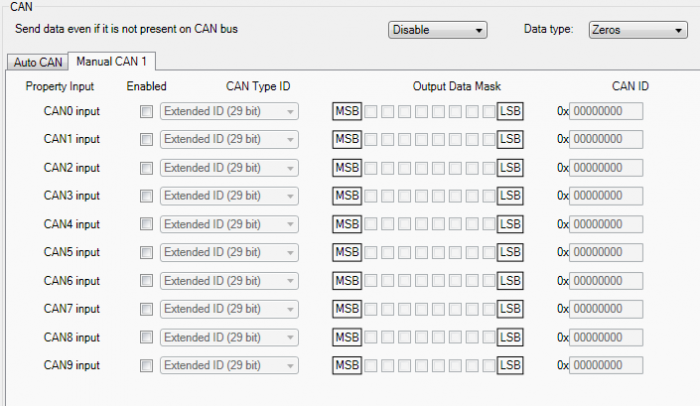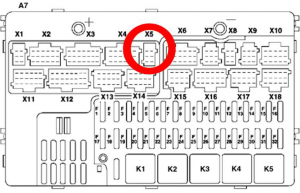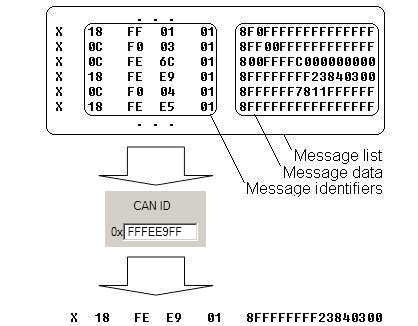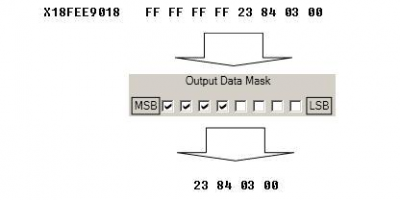Template:FMB630 Manual CAN: Difference between revisions
No edit summary |
No edit summary |
||
| Line 116: | Line 116: | ||
The example indicates how fuel consumption message is selected and how configuration impacts this selection. | The example indicates how fuel consumption message is selected and how configuration impacts this selection. | ||
{{{image6|[[Image:FMB630_manual_CAN6.png| | {{{image6|[[Image:FMB630_manual_CAN6.png|450px|center]]}}} | ||
When certain message is filtered, {{{model|FMB630}}} checks which data bytes should be sent to server. Document indicates that 5-8 bytes are used in FMS standard. | When certain message is filtered, {{{model|FMB630}}} checks which data bytes should be sent to server. Document indicates that 5-8 bytes are used in FMS standard. | ||
Revision as of 12:29, 1 June 2018
Controller Area Network (CAN or CAN-bus) is a computer network protocol and bus standard designed to allow microcontrollers and devices to communicate with each other and without a host computer. It was designed specifically for automotive applications but is now also used in other areas.
SAE J1939 and J1708* is the vehicle bus standard used for communication and diagnostics among vehicle components. Based on the same architecture FMS protocol dedicated to telematics systems is available. It has certain standardized parameters available, such as fuel consumption, engine work-hours, etc. Please visit http://www.fms-standard.com/ for more information and message structure.
The FMS-interface is an optional interface of different truck manufacturers. Supported information is dependent upon vehicle equipment. For the full information set, additional Electronic Control Units (ECU) may be required. Please contact the manufacturer or your dealer for more details.
Vehicle brands supported:
• Mercedes Benz
• Volvo
• MAN
• DAF
• Iveco
• Scania
• Renault
Available parameters:
• Total Fuel
• Total Distance
• Status of brake pedal *
• Engine Torque *
• Actual fuel
• Accelerator pedal position *
• Status engine brake
• Speed *
• RPM
• Engine hours
• Vehicle Weight *
• Fuel level
• Tachograph data *
Availability of parameter depends on vehicle’s model and configuration of FMS interface of the truck. J1708 is additional FMS protocol used by some vehicle manufacturers. If your vehicle supports J1939 and J1708 both protocols then you must disable J1708 in configuration to receive fuel data.
General description:
- CAN works if no USB cable is inserted and isn’t in deep sleep mode;
- Uses six different speeds: 50 kbps, 100 kbps, 125 kbps, 250 kbps, 500 kbps, 1000kbps;
- Auto Baud rate detection;
- Filtering messages (StId, ExtId) according to configuration;
- Using mask, filters required bytes;
- Different CAN configurations.
Configuration
Manual CAN data can be configured using “Manual CAN” in CAN tab.

CAN message ID type: Message ID type two types according to SAEJ1939 standard: Standard ID (value: 0 to 0x7FFh) and Extended ID (value: 0 to 0x1FFFFFFFh).

Message ID value is entered in hex format. This parameter is used to configure hardware message filter (Figure 90). All messages contain 8 bytes of data, to select particular data/bytes “Output Data Mask” is used, it’s done by ticking required bytes, only selected bytes are sent to server.

Example A sample CAN message has the following structure: X18FEE9018FFFFFFFF23840300, where essential parts are ‘FEE9’ – identifier and ‘FFFFFFFF23840300’ – data bytes. CAN messages are configured like any other I/O parameters. They consist of 4 identifier bytes and 8 data bytes. Below you will find a sample configuration for fuel consumption parameter: ID type – is always 29 bits. Output data mask – defines which data bytes are sent to the server (sometimes not all data bytes are necessary). CAN ID – this is 4 byte identifier. Messages use 4 bytes, but the first and last bytes may differ in different vehicle models while the middle four bytes are the same for all vehicles. The first and last bytes may have any value. Because of this reason it is recommended to write FF in the first byte and the same in the last byte.
This information is provided only as an example and Teltonika
takes no responsibility for information accuracy or damage that may be done to the vehicle or FMB630 module while integrating it.
Example: All Mercedes Benz Actros 2 models with Vehicle Identification Number (VIN) starting with WDB93 have a possibility to connect FMB630 module to CAN bus. This can be done by connecting to special PSM module (which may or may not be included in the truck) or ground module of the vehicle. For CAN signal to be available, parameter 520 must be enabled in “kommunikationsschnittstelle” in the vehicle with Mercedes Stardiagnose. CAN wires can be found on X5 connector located in the fuse box (Figure 91): Pin 5: CAN Low signal (yellow wire) Pin 2: CAN High signal (blue wire)

In the example FMB630 will filter all CAN messages with identifier FFFEE9FF (fuel consumption).

CAN parameter configuration example
Note: Averaging constant cannot be used with CAN data, because this information comes in digital format. So in order to prevent data loss, set Averaging constant parameter to 1.
Most parameters have certain resolution. FEE9 parameter has 0.5L/bit gain, so value that is sent to server has to be multiplied by 0.5. Data parsing is preceded by selecting correct message from all available on CAN bus. FMS standard interface description indicates that fuel consumption is parameter with ID FEE9:
FMS standard – fuel consumption 00FEE9 PGN Hex 65,257 PGN 1000 ms Rep. Rate Data Byte 1 Data Byte 2 Data Byte 3 Data Byte 4 Data Byte 5 Data Byte 6 Data Byte 7 Data Byte 8 Byte No. Not used for FMS-Standard Not used for FMS-Standard Not used for FMS-Standard Not used for FMS-Standard Total fuel used 0,5 L/Bit gain 0 L offset 5.2.5.66 SPN 250 Total fuel used 0,5 L/Bit gain 0 L offset 5.2.5.66 SPN 250 Total fuel used 0,5 L/Bit gain 0 L offset 5.2.5.66 SPN 250 Total fuel used 0,5 L/Bit gain 0 L offset 5.2.5.66 SPN 250 Name Values Values Values SAE ref SPN
The example indicates how fuel consumption message is selected and how configuration impacts this selection.

When certain message is filtered, FMB630 checks which data bytes should be sent to server. Document indicates that 5-8 bytes are used in FMS standard.
Table 58 FMS standard – fuel consumption (5-8 bytes) Data Byte 5 Data Byte 6 Data Byte 7 Data Byte 8 Byte No. 8 7 6 5 4 3 2 1 8 7 6 5 4 3 2 1 8 7 6 5 4 3 2 1 8 7 6 5 4 3 2 1 Bit no Total fuel used 0,5 L/Bit gain 0 L offset 5.2.5.66 SPN 250 Total fuel used 0,5 L/Bit gain 0 L offset 5.2.5.66 SPN 250 Total fuel used 0,5 L/Bit gain 0 L offset 5.2.5.66 SPN 250 Total fuel used 0,5 L/Bit gain 0 L offset 5.2.5.66 SPN 250 Name Values Values Values SAE ref SPN

Data bytes are filtered by selecting the checkboxes in Output data mask. Note, that configurator has them listed starting with MSB. After message is filtered it is attached to the data packet and sent to the server. Values are returned in HEX. 00 03 84 23(HEX) = 230435(DEC). Notice, that data resolution is 0.5L/bit gain – value has to be multiplied by 0.5, therefore vehicle used a total 115217,5 liters of fuel.
